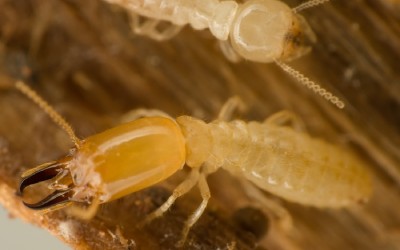Every year as the weather changes in the fall, pests start to make their effort to escape the cold. Insects that do not die off in the fall take part in a phenomenon called overwintering: they find a habitable environment to wait out the cold months of winter. Some insects will migrate to warmer clients, some find hiding spots outside under debris, while others try to get inside homes and buildings to stay warm.
Unfortunately for homeowners, the insects that try to overwinter inside warm buildings often end up in our homes, invading our bedrooms and kitchens. Often these fall pests will find low-traffic areas of homes like behind the walls or in the attic. The most frequent home invaders over the winter include rodents, termites, stink bugs, Asian lady beetles, and wasps. Continue reading to learn more about these common fall pests.
Rodents
Many pests can get into your attic by climbing up onto the roof. Squirrels are the most well-known culprits, but roof rats and mice are just as notorious for invading homes and making nests in the attic. How can you tell if you have rodents living in your home? The most common sign of a rodent infestation is scratching or gnawing sounds from above or from inside the walls; if you hear these sounds, it’s time to call an expert rodent exterminator.
Termites
The cost of termite damage in the United States is estimated to be up to $30 billion annually – it will come as no surprise that they are considered the most destructive pest in the country. While termites are present all year, fall and winter can worsen an already-existing infestation. Like many pests, subterranean termites burrow deeper into the ground during the cool months to survive cold weather, allowing the infestation to cultivate undetected until the following spring. Going undetected during the cool months allows these colonies to do significant damage to the wood structures of a home. How can you tell if you have termites? You may notice blisters on painted wood surfaces, pinhole-sized holes, and hollow-sounding wood.
Stink Bugs
Another common pest that hides undetected during the winter, typically in attics, crawlspaces, or behind the walls, is the stink bug – known for their shield-shaped bodies and their mottled coloring of brown and gray. The most common species, the brown marmorated stink bug, ranges in size between about ¼” to ⅜”. Unsurprisingly, stink bugs release an unpleasant odor when they feel threatened or are squished, as their name suggests.
Asian lady beetles
Asian lady beetles look very similar to ladybugs, but have a few distinct differences: they tend to be a bit larger, and though their coloration is similarly reddish orange, they do not all have spots. These insects can be found in groups and communicate with each other using pheromones – so if one lady beetle finds its way into a nice warm crack in your home, you’re likely to have a large infestation on your hands. Asian lady beetles do not pose any direct threat to your home’s structure and don’t bite or sting, but they can trigger allergic reactions in individuals with sensitivities and breathing problems. Additionally, their waste can stain, leaving behind an unsightly mess.
Wasps
Generally speaking, wasps die off before each winter and the colonies do not overwinter like the rest of the insects on this list. But to keep the colony thriving the following year, the fertilized queens will find a warm hiding spot to overwinter, often in stumps or hollow logs outdoors, or in protected structures like crawlspaces and attics. This can often lead to wasp infestations the following year when the queens restart their colonies.
Trusted Local Exterminators
If you have any of the pests on this list in or around your home in the Winston-Salem or Greensboro NC area, contact McNeely Pest Control right away. As the local leader in fast, effective, and long-lasting pest control services, McNeely Pest Control is equipped to keep your home pest-free all year long.


